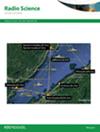微雨雷达和辐射测量揭示边界层以下和边界层以上雨微观结构的对比特征
IF 1.6
4区 地球科学
Q3 ASTRONOMY & ASTROPHYSICS
引用次数: 0
摘要
Ka 波段微雨多普勒雷达是根据雨滴大小分布(DSD)研究降水微观结构剖面的有效工具。随高度变化明显的 DSD 参数表明了相关的大气现象。因此,本研究利用微雨雷达(MRR)和辐射测量数据,并辅以印度加尔各答(22.57°N,88.37°E)热带城市上空的再分析输出结果,努力揭示造成不同降雨微观结构演变的基本物理过程。MRR 揭示了降雨率(R)和质量加权平均雨滴直径(Dm)之间沿降雨高度的典型幂律关系(Dm = aRb)中普遍存在的显著偏差,特别是在强对流降雨事件期间,在大气边界层(ABL)上方。因此,提出了另一种适合解释 ABL 以上 R-Dm 变化的经验关系。此外,辐射测量和再分析结果表明,大气不稳定性的存在加上 ABL 上空的风切变影响,导致雨滴破裂加剧和通常 R-Dm 关系的偏差。因此,本研究旨在突出热带地区地基雷达测量的适用性,以设计降水定量算法,进行可靠的雨量估计。本文章由计算机程序翻译,如有差异,请以英文原文为准。
Micro rain radar and radiometric measurements to unravel contrasting features of rain microstructure below and above the boundary layer
Ka-band Micro rain Doppler radar is an effective tool to investigate the profiles of precipitation microstructure in terms of the raindrop size distribution (DSD). The DSD parameters that vary appreciably with height are indicative of the associated atmospheric phenomena. Hence the present investigation endeavors to put light on the underlying physical processes responsible for the evolution of varied rain microstructure profiles using micro rain radar (MRR), and radiometric measurements complemented with re-analysis outputs over an urban tropical location, Kolkata (22.57°N, 88.37°E), India. MRR unravels the prevalence of significant biases in the typical power law relationship (D
m
= aR
b
) between rain rate (R) and mass-weighted mean drop diameter (D
m
) along the rain height, especially during intense convective rain events, above the atmospheric boundary layer (ABL). Consequently, an alternative empirical relation appropriate to account for the R-D
m
variability above the ABL is proposed. Further, radiometric measurements and re-analysis outputs reveal that the presence of atmospheric instabilities coupled with wind shear impacts above the ABL contributes to the enhanced breakup of raindrops and the deviations in the usual R-D
m
relationship. Thus, the present study intends to highlight the applicability of ground-based radar measurements over the tropics to devise quantitative precipitation algorithms for reliable rain estimates.
求助全文
通过发布文献求助,成功后即可免费获取论文全文。
去求助
来源期刊

Radio Science
工程技术-地球化学与地球物理
CiteScore
3.30
自引率
12.50%
发文量
112
审稿时长
1 months
期刊介绍:
Radio Science (RDS) publishes original scientific contributions on radio-frequency electromagnetic-propagation and its applications. Contributions covering measurement, modelling, prediction and forecasting techniques pertinent to fields and waves - including antennas, signals and systems, the terrestrial and space environment and radio propagation problems in radio astronomy - are welcome. Contributions may address propagation through, interaction with, and remote sensing of structures, geophysical media, plasmas, and materials, as well as the application of radio frequency electromagnetic techniques to remote sensing of the Earth and other bodies in the solar system.
 求助内容:
求助内容: 应助结果提醒方式:
应助结果提醒方式:


